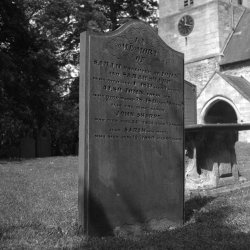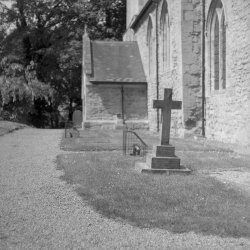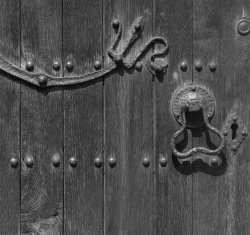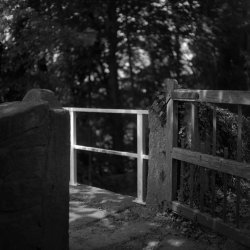I think you've got this technique down pretty well.
The first one showcases how this can help hold a long SBR, particularly given that Foma 400 is notorious for excessive contrast, and you got this at full box speed, to boot. Again, there are other ways to do this, certainly, but the range of light in that image from the distant shadows to the directly illuminated arch of the entrance is captured nicely by semistand.
As I've noted before, this kind of development approach is unforgiving of underexposure. No amount of standing will recover what wasn't captured on the negative. Since you're using full box speed, you don't have a lot of room for error. It can handle over exposure to a point. However, to my eye at least, when you do overexpose, you lose some of the midtone microcontrast that really makes the image "pop" because everything slides up the H/D curve, but that could just be my imagination.
When I do exposure placement, I normally only consider how place Zone III properly for the relevant shadows (not all shadows, because I have no objection to some shadows going black when the image benefits thereby). Because I often have to meter at a distance and cannot always isolate the "relevant" shadow, I typically take a couple exposures - one placed for what I believe to be the proper placement as best as I can judge it, and another with 1/2 stop more exposure as my "just in case" negative.
I normally don't much worry about highlight placement because I am using a semi-compensating developer (Pyrocat-HD) or a compensating developer (D-23) that will rein in very bright highlights. Moreover, because the film is standing for long periods of time, highlight development will stop relatively quickly as the developer exhausts due to lack of agitation. I easily have captured SBRs of 10 stops or even more this way.
I say "normally" because there are a couple cases where you have to think a bit differently. First, what to do with REALLY long SBRs. For example, shooting into the dark interior of a room with very bright light pouring into a window where you want to hold detail looking out that window.
The other case is when you have an overall really long SBR but the midtone areas lack dynamic range. For example, looking into a shaded wooden textured wall with little midtone range of light but with bright sun hitting some other part of the image, like a metal roof. This is where you want to use EMA to crank up the midtone local contrast a bunch. But EMA has more frequent agitations and the compensating effect due to developer exhaustion is less pronounced (because each agitation refreshes the highlights with new developer.)
In both these cases, I just dilute Pyrocat-HD more than usual. Instead of 1.5:1:200, I'll use 1.5:1:250 or even 1.5:1.300 to tame really long SBRs. I've not tried higher dilutions of D-23 for this because there is so little Metol in the stuff to begin with, I question whether you'd get good results with further dilution. Perhaps a test for another time.
What this all boils down to is to shoot at box speed, expose for the shadows, and adjust for the highlights only when- or as necessary via developer dilution. The long standing time at any of the aforementioned dilutions should pretty much give you the shadow detail you want (or close to it, you should experimentally confirm this).
This is unlike the more conventional Zone System advice of finding your personal ASA via endless densiometric tests, measuring the scene SBR and then doing N+ or N- development accordingly. Oh, and you get to do that for every single new developer/film combination.
In this sense, semistand/EMA is actually simpler to use, albeit at the cost of much longer development times. We simply hold development time constant and in some cases, change dilution - for any dilute developer you care to try and any film. That's it. I've personally tried this with a variety of Pyrocat-HD dilutions, D-23 1:1, HC-110 1:128 and with at least 10 different films total in various combinations. And it's always worked as expected. It even worked just fine with 60 year old Super XX sheet film! The only thing that likely won't work here is very rapidly oxidizing developer like PMK Pyro.
One other thing I want to try is to duplicate the old "dip and dunk" development procedure practiced by local photo shops many decades ago. It's essentially a much longer version of semistand. You load the film into your reel or pinch hanger or whatever, give it a good vigorous agitation for a few minutes and let stand for an hour or two towards the end of the day. Then you give it another good 30-60 seconds agitation or so, drop it in developer, and let it sit overnight to be stopped, fixed, and washed in the morning. Supposedly, this was a common practice in retail photo shops many years ago. Oh, and the developers the labs used was ... D-23. It's likely they did so because they couldn't guarantee that their customers were practicing good exposure hygiene. Doing extended semistand would extract maximum shadow detail while still preserving highlights. What I do not know (and thus want to try) is whether modern films will tolerate such long standing times.
P.S. I know you probably weren't shooting for art's sake, but I really like the aesthetic of the image 3 though I'd love to see the entirety of the "button" in the upper right to balance off the picture.











